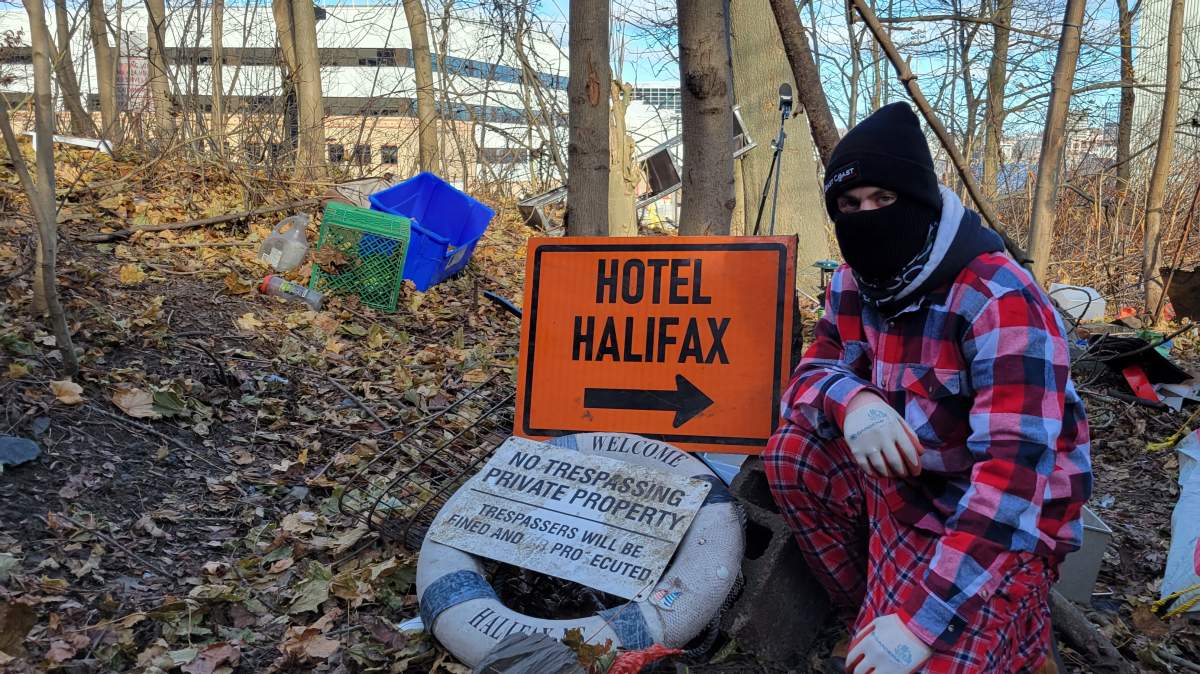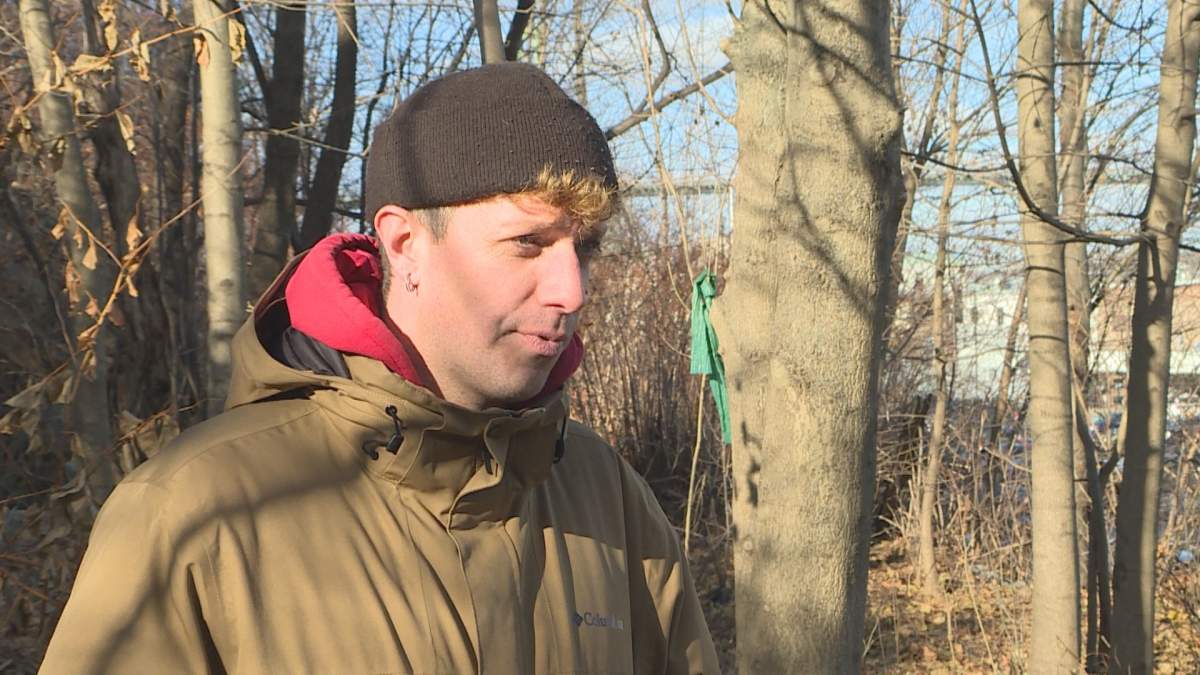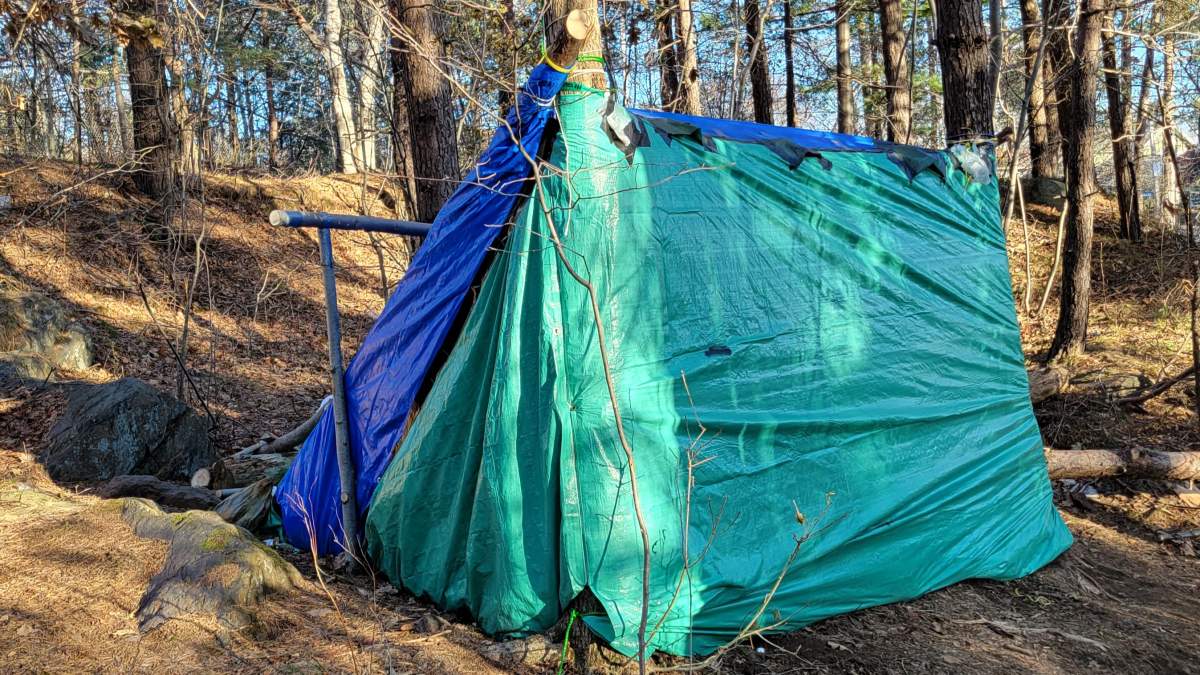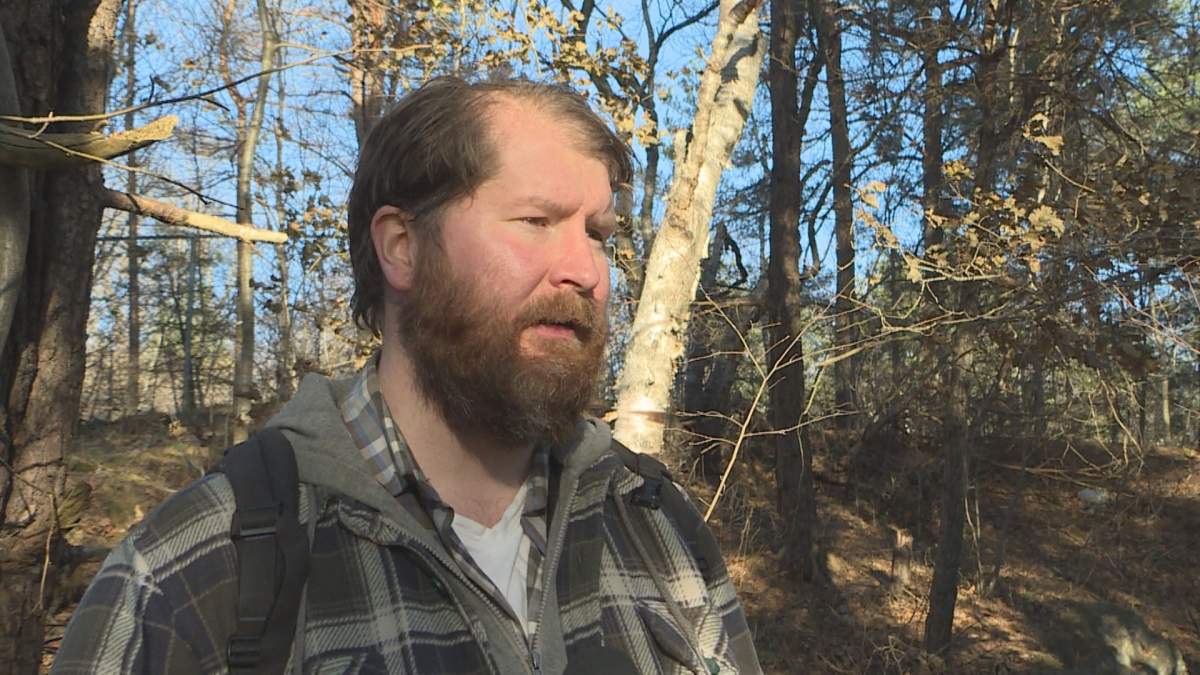This is Part 1 of a two-part series on homelessness in Halifax. Here is Part 2, which includes interviews with provincial and municipal officials.

Kyle just wants a safe, affordable place to call home.
The 25-year-old lives in a tent in a wooded area of a designated tenting site in Halifax, one of the few places where unhoused people can live with some certainty that they won’t be hassled by police or city officials.
“You don’t really know how each day’s going to pan out,” Kyle said of living at the site. “But you’re alive at the end of the day.”
Global News has agreed to use his first name only, due to the stigma people in the homeless community can face.
As the weather grows colder, Kyle keeps warm by going to libraries or fast-food restaurants when he’s able to get a gift card. He also uses a small propane lantern for heat.
His tent is waterproof, so he can at least stay dry.
“It’s pretty good,” he said. “The tent sometimes freezes, but hey, that’s to be expected with a tent in the winter.”
Kyle has been living outside for about 10 years. Finding employment has been difficult, he said – due to both being in and out of correctional facilities and previous work-related injuries.
He’s tried to access the emergency shelter system, but those stays are few and far between.
“They’re all full,” he said. “It’s pretty hard to get into a shelter in the city.”
‘They don’t want to admit what is happening’
In the summer, Halifax regional council designated four sites where unhoused people could tent. A fifth site has since been established in the Sackville area.
This coincided with the clearing of Meagher Park, also known as People’s Park – an area where unhoused people and volunteers built a community in the aftermath of the police-led encampment evictions in August 2021.
At the time, the city said those staying at Meagher Park would have to vacate “following deteriorating health and safety conditions at the park” – but those same conditions are now plaguing the sites where unhoused people were sent instead.
While Kyle once had neighbours, most of them have since left due to a rat infestation. During his interview with Global, rats could be heard rustling in the bushes nearby.
Kyle said nothing has been done to improve conditions at the site and he questions why the city designated the sites in the first place if they aren’t being kept habitable.
“They just don’t want to really look at what’s happening. They don’t want to admit what is happening,” he said.
“They just want to hide all the homeless people into certain encampments that they claim that they’re going to keep maintained, but they’re rarely maintained.”
Kyle said if people leave these designated sites due to poor conditions, they then run the risk of “being charged, or tents being removed and torn down by the city or by police … all because we do not feel safe in the sites that they sanctioned, that are deemed safe and fit for the homeless.”
Nathan Doucet, an outreach worker with Out of the Cold Community Association, said moving unhoused people into the few designated tenting sites contributes to their “invisibilization” – where they are pushed out of the public eye and made to bear the burden of homelessness on their own.

Get breaking National news
With these sites now dealing with the same issues the city used as a reason to shut down Meagher Park, unhoused people have to make the difficult decision to either live with rats or take their chances in an unsanctioned site.
“People quite literally can’t come here unless they engage in something very, very uncomfortable and kind of scary for a lot of people, meaning that they can’t come together and help each other organize,” Doucet said.
“It creates a lot of precarity for the people living outside, when there’s not an ability to group together and take care of one another, or share resources … which just leaves you more vulnerable in general.”
For Kyle, this invisibilization feels “pretty sh–tty.”
“Even though I say we’re homeless, we’re still people. We still have humanitarian rights,” he said.
“If we don’t feel safe here, if we go to another park that is fully safe … why does the city have to come and involve police or involve tearing down our tents and stuff?”
‘Winter is here’
Doucet, who also used to work outreach in Toronto, said he’s concerned for the safety of unhoused people as the coldest season sets in.
“Winter is here. The ground is cold, the ground is frozen. I know folks in Toronto and here that have lost their limbs, that have lost their toes,” he said.
“I’m worried that we’re going to see loss of life. I’m worried that we’re going to see loss of limbs.”
He said he and other outreach workers give out sleeping bags, tents, sleeping mats, lanterns, butane, stoves and emergency blankets – but “people need way more than the basic supports that we can provide for survival.”
“You’re still dealing with the chaos of what it means to live outside. People need mental health supports, they need harm reduction supports, they need all these things to help them create a foundation for themselves,” he said.
“But … just the sheer urgency of it all means people are living in a state where them being unhoused is all that can be focused on.”
Kyle agreed. His biggest barrier in bettering his situation, he said, is that all of his time and energy is focused on survival.
“It’s too cold, you’re freezing outside … so it’s just kind of hard,” he said.
Doucet loves his job, but says it’s difficult to not be able to get people what they truly need – housing.
“It’s completely infuriating. I am frustrated constantly, because what we’re doing is acting out of a specific mode of care, but it’s not enough,” he said.
“We’re all worn thin. We’re all worried as heck and we’re super frustrated that people are obviously getting left behind without the supports that they need, but yet we’re sort of thrust into this position – a stop-gap in a housing crisis to provide basic supports that are ultimately just a Band-Aid solution.”
Doucet said with the rising cost of living, there are many more people this year who are experiencing homelessness for the first time.
According to the latest numbers from the Affordable Housing Association of Nova Scotia, there are now more than 700 unhoused people in the Halifax area alone – an increase of more than 200 from a year ago.
What’s needed, he said, is more housing with rent geared to income to help low-wage workers and people on fixed incomes stay off the street.
“We’re seeing condo developments and a lot of development across the city going up, but there’s nothing being instituted … for rent-geared-to-income housing only,” he said.
“It is absolutely what is needed if we’re going to provide reasonable, sustainable housing for people, especially those living outside.”
The issue, said Doucet, is that the people making decisions about homelessness and housing don’t have a full understanding of what unhoused people need to go through every day just to survive.
“There’s such a disparity between those who are making the decisions and those who are actually going through it,” he said.
“And here we are, moving into another winter. There’s more people living outside than ever. The basic supports don’t exist and rent-geared-to-income housing doesn’t exist.
“And rarely do we see in those moments people actually coming into the parks to meet with people and to find out what they actually need.”
Homelessness ‘growing and growing’
In another designated Halifax tenting site, an unhoused man who did not want to be identified lives in a tent with his dog.
He said he had been living there for about three months after getting kicked out of his previous place, but he’s been homeless on and off for years.
Living there is “not so bad,” he said, though he wishes there was some sort of power hookup to charge his phone and make it easier to cook. He said he bundles up and uses candles to heat himself during the colder months.
“It is what it is, I guess. Make do with what you got,” he said.
The man said it’s been difficult for him to access housing because of affordability and challenges with his mental health, as well as a lack of pet-friendly places.
His dog means he is also unable to access shelters. He said he would like to see more resources for unhoused people who have pets.
“When you get kicked out of a place or something, you don’t want to give up your best friend,” he said. “He keeps me going, basically.… I’m not going to get rid of him.”
Eric Jonsson works as a street navigator with the city. His job involves travelling around the city’s downtown core, seeking out people struggling with homelessness and helping them in any way he can.
In the last year alone, he said the number of people on the street has grown substantially.
“There’s just more people who are homeless,” he said.
“It seems like for every person we get off the street, two more people show up the next week and it keeps growing and growing.”
He said the designated tenting sites are working “as intended” in that occupants don’t have to worry about being kicked out by police or the city, but said there are still challenges. For instance, people don’t have access to power and their bottles of water freeze in the winter.
While the Affordable Housing Association of Nova Scotia homelessness estimate of 700 includes people using shelters, hotel rooms and transition houses, Jonsson estimated there are more than 100 people sleeping outside in the Halifax area on any given night.
He said he counted 85 people a couple of weeks ago, but there are likely many more.
Jonsson said the housing and homelessness crisis has been a long time coming.
“It’s just a slow-moving disaster that (everybody) who pays attention to homelessness and housing could see coming, and it just finally catches up to us. And I don’t think there’s much of a plan to make it better any time soon,” he said.
“There’s a lot of really cool organizations doing really good work, but they’re all just chipping away at the problem. There’s no kind of overarching strategy, there’s no kind of big plan to get those numbers back down and to get people off the streets.”
Jonsson agreed the province needs to build more private and non-market housing, noting that the biggest barrier for many people in trying to find housing is simply getting their foot in the door.
“I really don’t think the private market is the answer for a lot of people,” he said.
Jonsson said his program is funded better than ever before, but he can only do so much.
“I spend hundreds to thousands of dollars on tents a year, and it just seems so silly when that money should be spent on rent,” he said.
“A lot of times, the budget for my program would be enough to put a down payment on somebody’s house. So why can’t we just build houses or buy houses and give them to people who really need them instead of funding these really Band-Aid, temporary solutions?
“Which isn’t to say my work isn’t important … but every year, it’s like, how many thousands of dollars are we going to spend on tents instead of actually housing people?”
— with files from Alicia Draus













Comments